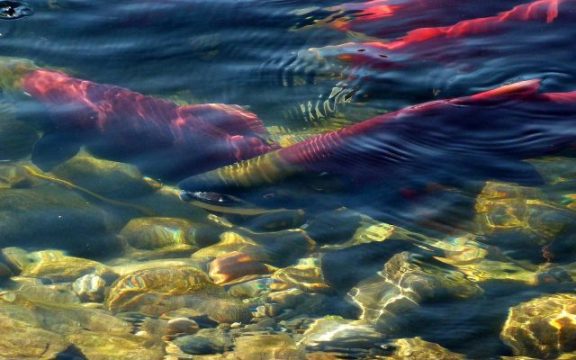Imagine a fish that’s barely alive—its skin peeling, eyes clouded, and body rotting—yet it still swims upstream, fights rivals, and fulfills its final mission. Welcome to the bizarre and brutal world of zombie salmon. These haunting creatures are far from the sleek, silvery swimmers we associate with salmon. After a long ocean journey, they return to the rivers where they were born—and undergo one of the most extreme biological transformations in the animal kingdom.
Spawning is the final act in the salmon life cycle, where adults lay and fertilize eggs in freshwater streams before dying. For Pacific salmon species like sockeye and chinook, this journey is a one-way trip. Their bodies begin to break down the moment they re-enter freshwater, as they stop eating and pour every ounce of energy into reproduction. It’s a relentless, gruesome, and awe-inspiring process of life giving way to new life.
In this listicle, we’ll dive into 10 startling facts about zombie salmon, uncovering the fascinating—and often unsettling—realities of their final days. From rotting while swimming to battling to the death, these fish embody the raw, relentless drive of nature. What they endure is not just survival—it’s sacrifice at its most extreme.
10. They’re Technically Still Alive—Barely
Despite their ghastly, rotting appearance, zombie salmon are not truly dead — not yet. These fish enter a bizarre final phase of life after returning from the open ocean to freshwater rivers to spawn. Once this migration begins, they stop eating entirely, and their bodies rapidly break down: skin peels, eyes cloud over, and fungal growths can appear — all while they’re still alive and swimming.
But make no mistake — they’re still biologically functioning. Their hearts beat, their gills breathe, and their muscles contract as they navigate upstream with a single-minded mission: to reproduce before death.
Fun Fact: Scientists describe this phase as “semelparity” — a biological strategy where animals reproduce once, then die shortly after.
This strange twilight state has earned them the nickname “zombie salmon”, but in reality, it’s a stunning act of evolutionary resilience. Despite decaying externally, these fish fight off predators, defend nesting territory, and often die only minutes or hours after spawning is complete.
From a survival standpoint, it’s a brutal trade-off: sacrifice everything for the next generation. And it works — these species have persisted for millions of years thanks to this grisly yet effective strategy.
9. Bears Love Zombie Salmon — But Only the Best Bits
To us, zombie salmon may look like nature’s horror show, but to bears—especially grizzlies and brown bears—they’re a high-fat, high-reward seasonal delicacy. During the fall salmon run, bears line the banks of rivers and creeks to gorge on these decaying fish in preparation for winter hibernation. But they don’t just eat everything—they get selective.
Many bears practice what scientists call “selective foraging”: tearing open a zombie salmon just to eat the richest, fattiest parts, like the brains, eggs (roe), and skin, while leaving the rest of the carcass uneaten. This strategy is all about efficiency: maximum calories, minimal effort.
Fun Fact: A single salmon brain contains more fat per gram than its entire muscle tissue—perfect fuel for fattening up fast.
But this isn’t just about bears getting ready for a nap. The carnage they leave behind—half-eaten salmon strewn across the forest floor—nourishes entire ecosystems. Rotting fish carcasses feed scavengers like eagles and foxes. Nutrients from the fish seep into the soil, enriching the forest and even accelerating tree growth. In some regions, scientists have found up to 70% of the nitrogen in riparian trees originates from salmon.
In this way, zombie salmon play a vital role as nutrient delivery systems, turning death into life and feeding the forest from riverbank to treetop.
8. Some Are Covered in Fungus
As zombie salmon near the end of their life cycle, their immune systems collapse, leaving them vulnerable to infections. One of the most eerie — and unmistakable — signs? Patches of white, fuzzy fungus spreading across their heads, fins, and wounds.
This fungal growth is usually caused by Saprolegnia, a common aquatic water mold that thrives in cold, oxygen-rich freshwater. It feeds on damaged skin and tissue, especially in fish weakened by stress, injury, or — in this case — the immense physical toll of spawning migration.
Science Spotlight: Saprolegnia isn’t always lethal on its own — but on zombie salmon, it accelerates external decay, causing scales to slough off, fins to rot, and lesions to spread. Combined with cloudy eyes and torn bodies, it completes their haunting transformation.
While it may look like a disease outbreak, this gruesome appearance is actually part of nature’s design. The salmon are on a one-way path — they’ve stopped eating, focused all energy on reproduction, and are slowly shutting down. Fungus simply helps break them down, returning nutrients to the river system faster.
It’s unsettling, yes — but it’s also a powerful reminder that decomposition is part of the life cycle, and zombie salmon, fungi and all, are crucial to the health of aquatic and surrounding forest ecosystems.
7. Their Eyes Turn Cloudy and White — But They Still Find Their Way
One of the eeriest signs that a salmon is nearing the end of its life is found in its eyes. As zombie salmon deteriorate, their once-clear pupils often turn cloudy, glazed, or ghostly white — a transformation that gives them their undead, almost supernatural appearance.
This visual change isn’t just for show. It results from tissue breakdown, aging, and sometimes infections like fungal overgrowth or bacterial conjunctivitis. Since these fish stop feeding and redirect all available energy to reproduction, basic bodily functions — including eye maintenance — begin to fail. The result is a film over the eye that impairs vision.
Nature’s Workaround: Despite this vision loss, zombie salmon aren’t swimming blind. Pacific salmon are famous for their incredible sense of smell — they use chemical cues in the water to navigate hundreds of miles back to their exact spawning stream.
Even with dimming eyesight and decaying bodies, they power upstream using olfactory memory, detecting the unique “scent signature” of their natal river. It’s an astonishing feat of biology: a near-blind fish, in a state of decay, using smell like a living GPS to fulfill its final mission.
It’s just one more reason why zombie salmon are as fascinating as they are unsettling — survivors to their last breath, with instincts that override even physical decay.
6. They Undergo a Dramatic Color Change — From Silver to Surreal
One of the most striking—and startling—signs that a salmon has entered its zombie phase is its radical skin color transformation. Once sleek, silvery ocean swimmers, these fish morph into vivid, almost alien shades as they migrate upstream to spawn.
The change isn’t random. It’s triggered by a flood of hormonal shifts—including spikes in cortisol, testosterone, and estrogen—that prepare the salmon’s body for its final reproductive act. These hormones break down muscle and fat while simultaneously altering pigmentation and skin texture.
Biology in Action: These visual changes are a signal to other salmon: “I’m ready to spawn.” They play a key role in mate selection and spawning dominance.
- Sockeye salmon turn a glowing crimson with bright green heads, looking like creatures from another planet.
- Chinook and coho darken dramatically, sometimes developing mottled, bruised-looking patches.
- Pink salmon may appear pale, blotchy, or even “burned” as their skin deteriorates.
These intense hues serve a dual purpose: attracting mates while warning rivals during aggressive encounters. The brighter the fish, the more mature—and the more dangerous.
To the untrained eye, it’s both beautiful and grotesque. Bright red flesh, peeling skin, and stark contrasts of color make these creatures look like they’ve emerged from a nightmare. But to nature, it’s simply the final step in a perfectly evolved life cycle.
5. They Can Spread Nutrients—Even in Death
Zombie salmon don’t just die — they give life back to the world around them. After completing their spawning mission, these fish collapse in the same rivers where they were born. What follows is a powerful act of natural recycling: their bodies decompose and nourish the ecosystem from streambed to treetop.
Within days of death, their flesh begins to break down, releasing vital nutrients like nitrogen, phosphorus, and potassium into the water and nearby soil. These nutrients feed algae and aquatic plants, which in turn support insects and juvenile fish. But the impact doesn’t stop at the water’s edge.
Tree rings don’t lie: Scientists have discovered salmon-derived nitrogen in the growth rings of trees near spawning rivers, proving that these fish literally feed the forest.
Animals quickly take advantage of this buffet. Bears, eagles, otters, wolves, foxes, and insects feast on the remains. Whatever’s left behind is broken down by bacteria, fungi, and other decomposers. It’s a complete nutrient cycle — and salmon are the linchpin.
In this way, zombie salmon become ecological powerhouses, turning their death into a source of life. Without them, the rivers would be poorer, the forests thinner, and the entire Pacific Northwest food web far less vibrant.
4. They Die for Reproduction By Design
For zombie salmon, death isn’t an accident — it’s the end goal. Most Pacific salmon species, including sockeye, chinook, and pink salmon, follow a fascinating reproductive strategy called semelparity: they spawn once in their lifetime, then die.
As soon as they enter freshwater, salmon stop eating altogether. Every ounce of energy is redirected into an epic final push — fighting upstream currents, evading predators, battling rivals, and finally laying or fertilizing eggs. By the time spawning is complete, their organs are shutting down, their bodies are falling apart, and their mission is fulfilled.
Nature’s brutal brilliance: Semelparity may seem grim, but it’s an incredibly effective evolutionary strategy. By devoting all energy to one massive reproductive event, salmon maximize their genetic legacy.
And their sacrifice doesn’t just benefit their offspring. As we’ve seen, their bodies feed ecosystems, fertilize forests, and support countless other species. In dying, they pass the torch — both biologically and ecologically.
Their death is not a failure of survival, but a masterclass in purpose-driven biology.
3. Their Bodies Literally Rot While Swimming
Zombie salmon aren’t just dying — they’re decaying alive. Shortly after returning to freshwater to spawn, their bodies begin to break down from the inside out, even as they continue fighting upstream with astonishing determination.
Because they stop eating and pour all remaining energy into reproduction, their physical systems collapse one by one:
- Muscles shrink and weaken.
- Scales fall off.
- Fins become shredded.
- Skin peels away, revealing raw, damaged tissue.
As their immune systems shut down, their bodies become breeding grounds for fungus, bacteria, and parasites. Open wounds fester. Some develop grotesque growths. And in males, the jaw transforms into a hooked weapon known as a kype, giving them an even more monstrous look.
Unnatural endurance: These fish are literally rotting while swimming, still capable of fighting rivals and navigating rapids — all while their internal organs are failing.
It’s an almost unimaginable level of biological sacrifice — a slow-motion self-destruction carried out with purpose. Few creatures in the animal kingdom come close to this level of extreme, programmed decay in service of reproduction.
This is what makes zombie salmon so haunting — and so fascinating. They are nature’s ultimate martyrs, dying not just for life, but through it.
2. They’re a Vital Part of Indigenous Culture
Zombie salmon aren’t just ecologically important — they are deeply sacred to many Indigenous communities throughout the Pacific Northwest and beyond. For centuries, salmon have been central to spiritual beliefs, ceremonial traditions, and sustenance practices, symbolizing the interconnectedness of life, death, and renewal.
The annual salmon run — ending in spawning and death — is not viewed as tragic, but as a gift. Many Indigenous cultures honor this moment as a powerful act of sacrifice, where the salmon gives its body to nourish people, animals, forests, and rivers. Even the decaying form of the so-called “zombie salmon” is seen as a vital return to the Earth, completing the sacred cycle of life.
Cultural significance: In traditional stories and oral teachings, the salmon’s journey represents perseverance, balance, and reciprocity — living in harmony with nature, and giving back what is taken.
Tribes such as the Yurok, Tlingit, Nisga’a, Coast Salish, and many others hold First Salmon Ceremonies to show gratitude and ensure the fish’s return year after year. These rituals honor not just the food source, but the salmon’s symbolic power as a being that embodies endurance, purpose, and unity with the land.
To these cultures, zombie salmon are not grotesque or tragic. They are respected elders of the river — symbols of sacrifice, wisdom, and survival that continue to shape both land and legacy.
1. They Still Fight to the Death — Even While Dying
Even as their bodies decay and their organs begin to fail, zombie salmon refuse to give up. In their final days, these fish are consumed by one mission: to reproduce at any cost. And for many males, that means fighting — sometimes to the death.
During the spawning season, male salmon become intensely territorial and aggressive. Despite shredded fins, cloudy eyes, and rotting skin, they clash violently in shallow streams, using their bodies as weapons. Their jaws — now warped into hooked “kypes” — are used to bite, shove, and intimidate rival males in a brutal contest for mates.
Nature’s last stand: These aren’t just brawls of strength — they’re battles of endurance, instinct, and desperation. Even with failing systems, the salmon’s reproductive drive overrides everything else.
In many cases, these fights result in injury, exhaustion, or death. But salmon persist, fighting to spawn even when their bodies are falling apart. It’s a dramatic, almost mythic struggle — a final burst of biological willpower that defines their legacy.
This savage determination, displayed while their bodies rot in real time, makes zombie salmon one of the most tenacious and haunting creatures in nature. Their final act isn’t retreat — it’s resistance.



